Top 17 Back Pain Relief Exercises & Workouts

Lower back pain is one of the most common health concerns. People of different ages experience this condition for varied reasons. Some may develop back pain due to an acute disease like pancreatitis or an injury, while others experience it because they do not maintain their posture.
However, you can relieve this pain by exercising to relieve back pain. This is the best and most convenient method of strengthening the lower back. In addition, these exercises also improve flexibility and motion.

Table of Contents

What is Back Pain?
One of the leading causes of disability worldwide is back pain. It might vary in intensity from a steady, dull ache to an abrupt, acute pain that might go down the leg. It can sometimes develop gradually due to age-related degenerative changes in the spine, or it can occur quickly due to an accident, a fall, or carrying something heavy.
Fortunately, most back pain incidents can be avoided or relieved with some precautions, especially for those under 60. If prevention is unsuccessful, a few weeks of basic home therapy and frequent, proper body usage will heal the back.
Symptoms of Back Pain
Back pain symptoms can either come suddenly or emerge gradually. Other than grave medical conditions, posture and daily habits play an important role in developing this pain. People can experience different kinds of back pain depending on how it is caused. Here is a list of symptoms indicating a person suffers from back pain.
- Muscle Stiffness: This is common when people find it difficult to move or straighten their back. It becomes difficult for them to stand or even sit upright in this situation.
- Spasms: Spasms are caused by muscle strain. This is an extremely painful symptom, and it restricts every kind of body movement.
- Crooked Posture: Someone with a bent or crooked posture and misaligned structure might be suffering from back pain. Now that you know the symptoms, let's move on to their causes.
Causes of Back Pain
Countless causes can eventually result in unbearable pain in the back. Some of the common causes include:
- Strains on Muscles or Ligaments: Muscle strain can result from two situations: continuous heavy lifting of objects or sudden movement. However, if someone gets regular muscular strains in the lower back region, it will eventually lead to back pain.
- Bulging or Ruptured Discs: Discs are like cushions between bones in your spinal cord. They can rupture from any accident and press the nerves. Many people continue to live with this condition without feeling any ache. However, you will feel like a push down on the nerve.
- Degenerative Disc Disease: This is a kind of condition where the discs shrink or tear. Resulting in the bones getting rubbed. A condition like this is prevalent in older people.
- Inflammation and Wear of the Sacroiliac Joint: The sacroiliac joint is the juncture where the spine connects the pelvis. This joint does not move much, but it is responsible for the movement of the upper body. Hence, any accident or injury causing inflammation or wear on this joint can result in tremendous lower back ache.
- Spondylolisthesis: A condition when the vertebrae in the spine slip out of place. Those suffering from this situation also encounter lower back aches and leg pain.
- Spinal Stenosis: In simpler terms, this is a structural problem. It happens if the spinal column is very narrow for the spinal cord. It results in causing severe sciatic pain in the nerves as well as in the back.
Other than these, there can be some additional causes for back pain, this includes:
- Vertebral Fractures
- Arthritis
- Overweight
- Stress and anxiety
- Heavy lifting
- Slouching while sitting
- Smoking
- Wearing high heels
- Pregnancy
- Kidney stones
- Endometriosis
- Fibromyalgia
Muscle Strengthening Exercises
1. Glute Bridge
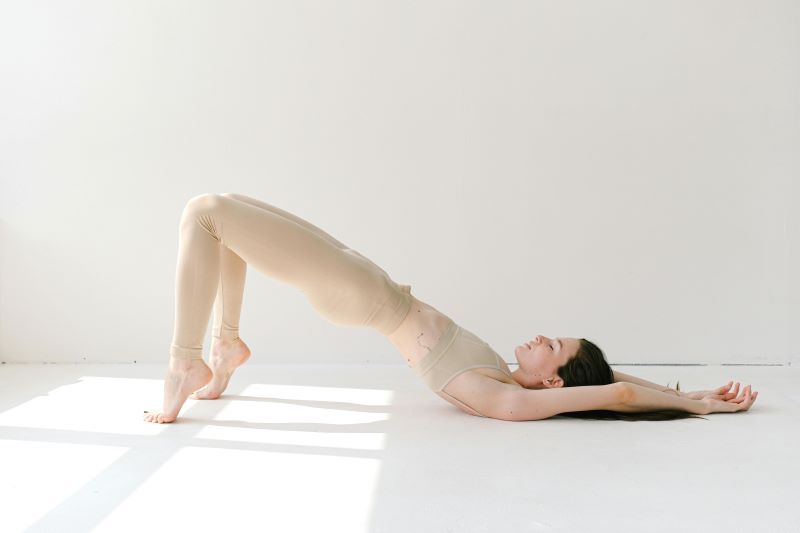
As the name suggests in this strengthening exercise, your aim is to work on the glutes. It helps stabilise and support the lower back and hips. This is how you can do the exercise at home. Lay down with your knees bent and the hips width apart. Keep your arms on the side and palms facing upwards.
Now, tighten the abdominal muscles and squeeze your glutes. Then, lift your pelvis until it forms a straight line through your shoulder. Hold it for a few seconds and then return to the first position. Repeat these steps 10-15 times.
2. Bird-dog

Among the other back pain exercises at home, the bird-dog position is probably the most effective one. Along with working on the glutes, this also impacts the back extensor muscles. This is how one can do the bird-dog pose. At first, kneel and place your hands on the ground. Ensure the shoulders are over your hands and the back is above your knees.
Tighten your core, slowly stretch your right arm, and hold this position. Now, extend the left leg, and stay in this posture for a while. Slowly get back to your resting position. Repeat these steps at least five times.
3. Plank

Although plank primarily works on the abdominal region, it also engages arms, shoulders, flexors, hips and feet. Therefore, planks help do a full-body workout. It is also a great exercise for back pain. Follow these steps to do a plank in the right way.
Start by lying on your stomach with your arms against the floor, and the elbows align with your shoulders. Tighten your gluteal muscles along with your abdominal muscles.
Lift your hips and the knees, and come to a straight position. Stay in this position for 10-30 seconds, or as long as you can, without bending your knees or sagging your pelvis. Slowly lie down and rest for a minute, then repeat five times.
4. Abdominal Drawing-in Manoeuvre
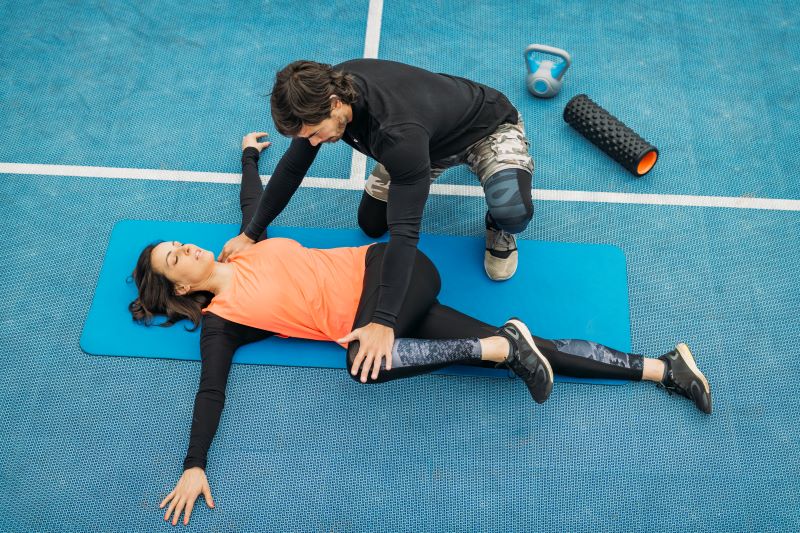
Weaker abdominal muscle is one of the many reasons for back pain. Therefore, by doing this manoeuvre, one can strengthen their core. To do the ADIM at home, you must follow these steps. First, lie down on your back with bent knees and your arms on the side. Ensure the spine is straight. Inhale and pull the belly button.
While exhaling, tighten the abdominal muscles and keep drawing your belly button towards the spine. Stay in this position for at least 10 seconds, then slowly release the muscles. Rest for a few seconds, and then repeat this 10 times.
5. Abdominal Crunches
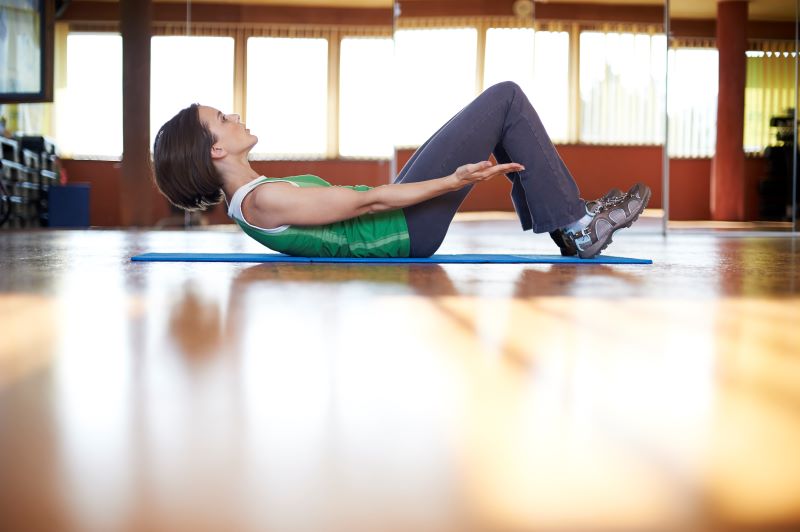
By doing abdominal crunches, you can develop stronger core muscles. Particularly, experts suggest this exercise to reduce back pain. This is how you can do this. At first, start by lying on your back, knees bent and hips wide apart.
Keep your hands crossed on your chest or reach the sides of your body towards the feet. Now, you need to tighten your abdominal muscles. While exhaling, slowly lift the head as well as the shoulder blades off the floor. Return to your starting position, and repeat this 10-15 times.
6. Pelvic Tilt

This exercise is known for strengthening muscles in the abdominal region. By doing pelvic tilt, you can eventually feel relieved from back pain. You can follow these steps to impact the glutes and hamstrings as well.
Lay down with bent knees and flat feet. Then, ensure to engage your abdominal muscles while laying down. Keep breathing naturally while concentrating on inhaling and exhaling. Release and take deep breaths. Keep doing this in repetitions for some time.
7. Partial Crunches
Partial crunches are an effective exercise without adding too much effort, as with full crunches. You can follow these steps to do this exercise at home.
Lie on your back with your knees bent and hands behind your head. Lift your shoulders off the floor, curling towards your knees while keeping your lower back on the ground. Hold for a few seconds, then lower back down. Repeat several times.
8. Supported Bridge Pose

A complete bridge pose can be difficult with a stiff back. Therefore, add support underneath your back using a yoga block or a ball. Follow these steps for an effective supported bridge pose.
Lie on your back with knees bent and feet hip-width apart. Place a yoga block under your sacrum (lower back) and rest your hips on it. Extend your arms by your sides with palms facing up. Relax into the pose for several breaths.
Stretching Exercises
Stretching exercises can be a great tool to combat back pain. Tight muscles in your back and legs can strain your spine. Stretching helps loosen these muscles, reducing tension and pain. This improved flexibility can also make everyday movements easier, preventing future discomfort. Here are a few stretching exercises:
9. Knee-to-Chest Stretch
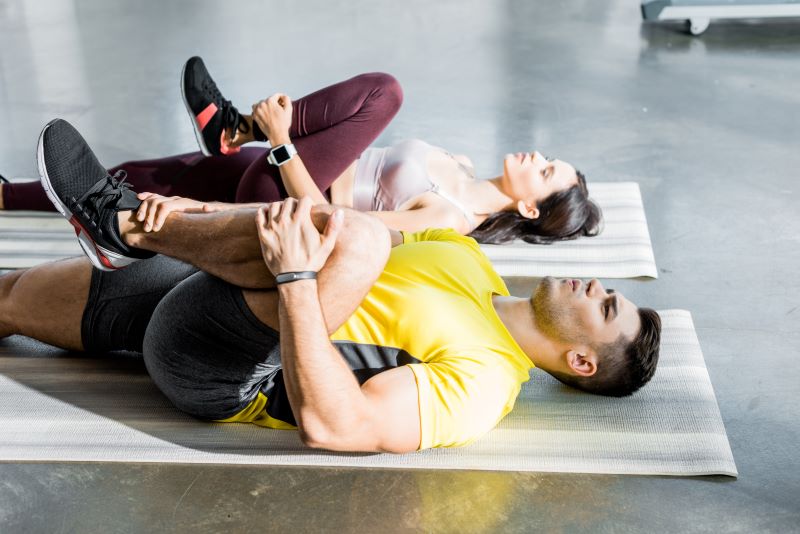
The first stretching exercise you can do to relieve back pain is the knee-to-chest stretch. This can relieve tension and elongate the muscles in your lower back. To stretch, you must follow these steps: Lie down with your back. Uplift the right leg and slowly bend the knee to the chest.
Try pulling the knees towards your chest. Hold onto this position for as long as possible, and breathe normally. Repeat the same with another leg. Finally, return to your starting position.
10. Modified Seated Side Straddle

This exercise stretches the hamstring, abductors, and extensor muscles in the middle and lower back. You can do it at home by following these steps. First, sit upright with your legs forming a ‘V’ shape. Bring your left leg to touch the right knee and let the left knee fall out.
Keep your back straight, bend from your hips and reach the toes of the right floor. Round your back, and bring your hands to the right ankle or shin while lowering your head towards the right knee. Stay in this position for 30 seconds, then relax and repeat 5-6 times.
11. Kneeling Back Stretch
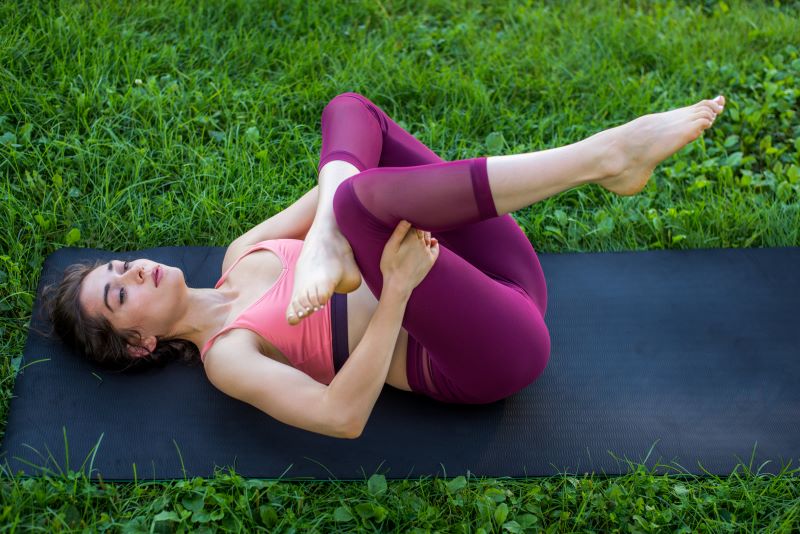
This exercise also stretches your back muscles while easing the pain and tension. You can easily do this stretching by following these simple steps. Get to the position in such a way that you are on your hands and knees. Your shoulders must align with your hands, and your hips must be width apart. Pull your belly button to the spine while tilting the lower back towards the floor so that you are making a circle.
Stay in this posture for a while. Gently rock backwards, and lower your hips to bring them closer to the heels while your arms are stretched out. Again, hold this position. Slowly get back to the starting pose and repeat 10-15 times.
12. Piriformis Stretch
One of the best exercises for back pain at home is stretching the piriformis muscles. In addition to reducing back pain, it strengthens your hips and lowers your back. This is how you should do the stretch.
First, lie down with your knees bent. Place your right ankle to touch the base of your left thigh. Keep your hands behind your left thigh and pull them to the chest. Stay in this position for at least a minute. Repeat the same on the other side.
13. Sphinx Stretch

This gentle backbend stretching strengthens your hips, spinal cord, and chest. Here are the steps for the sphinx stretch: Start by lying on your stomach. Your elbows must be aligned with your shoulders. Your hands must be extended with palms facing the ground. Keep your feet slightly apart.
Lift your upper body and engage the lower back, hips and thighs. Maintain the strength of your back and the abdominal region while focusing on heavy breathing. Your pelvis must stay on the floor. Keep your face straight but your eyes closed. Stay in this position for a minute and repeat these steps.
14. Balasana or Child’s Pose
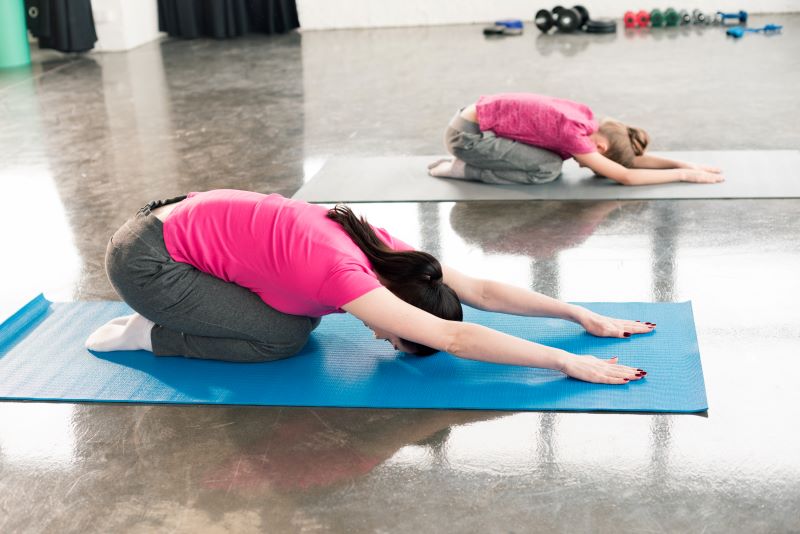
This posture strengthens your glutes, spinal extensors, and thigh muscles. Balasana is also one of the best exercises for back pain. It has proven beneficial in loosening tight back muscles and promoting flexibility. These are the steps for doing the child’s pose. While sitting on your knees, extend your hands.
Fold forward, keeping your hands out in front and your belly on the thighs. Move your arms alongside your body. Concentrate on your breathing while relaxing muscle tightness. Hold this position for a minute, then return to the starting position and relax for 30 seconds before repeating.
15. Ardha Matsyendrasana or Seated Spinal Twist
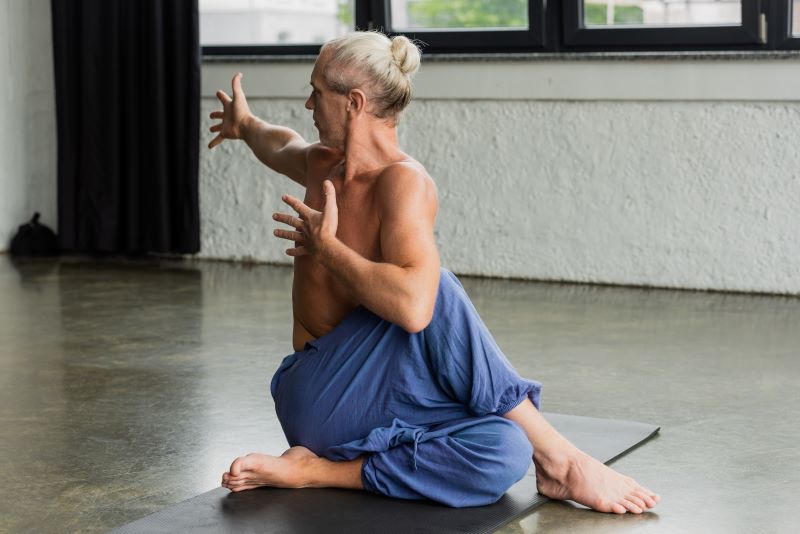
This classic twist pose stretches your hips, glutes, back, shoulders and neck. The pressure generated from this yoga asana also stimulates certain internal organs. To perform this posture at home, follow these steps. Sit on the floor and keep your legs extended.
Now, bend your left knee and place your foot outside the right thigh. Keep your right arm outside of your left thigh and support yourself with the left hand behind you. Gently twist your body to the left side. Try to stay in this position for a minute. Slowly return to the starting position and repeat the same for the opposite side.
16. Marjaryasana or Cat-Cow Pose
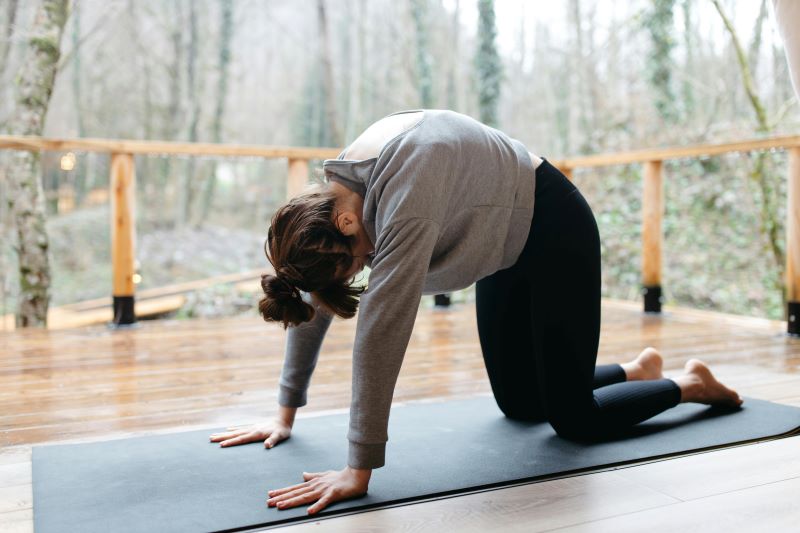
One of the most effective exercises for back pain is Marjaryasana. This posture wakes your spine while stretching from the neck and shoulders to the chest. To do this movement at home, follow these steps: Get on your knees and hands for a tabletop formation.
Push the ground as you tilt your head back while inhaling. Then, exhale, tuck your chin into the chest, and make an arch with your spine. Keep doing this pose with every breath for 1-2 minutes.
17. Seated Forward Bend (Paschimottanasana)
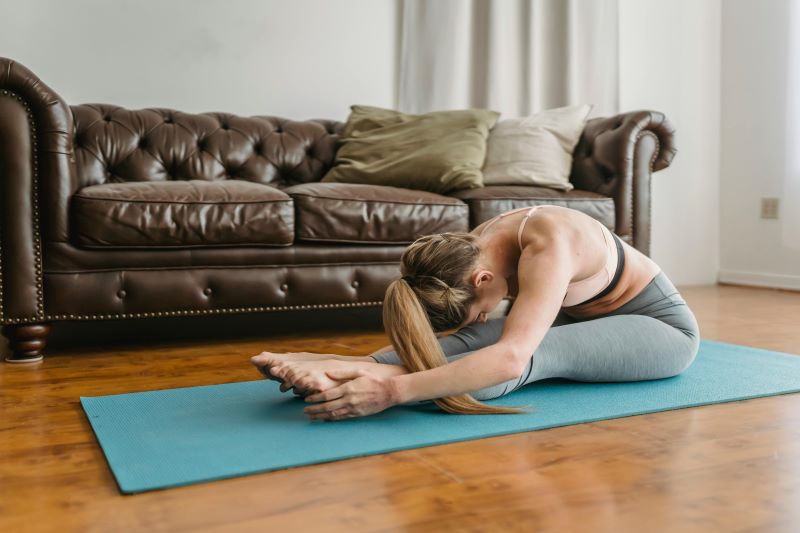
Paschimottanasana is an excellent yoga pose for ensuring flexibility and stretching your spine. It is renowned as the destroyer of sickness and helps reduce bodily stress.
Sit on the floor with your legs extended in front of you. Inhale as you lengthen your spine, then exhale as you hinge at your hips and fold forward, reaching for your feet. Keep your back straight and avoid rounding your spine excessively.
Practise these poses mindfully and gently, listening to your body and avoiding any movements that cause pain or discomfort.
Types of Equipment Required for Back Pain Exercises
Equipment for back pain exercises can vary depending on the specific exercises and the severity of the back pain. Here are some common types of equipment that might be used:
Equipment |
Exercises |
| Yoga Mat | Stretches and core strengthening exercises |
| Stability Ball | Core stability and balance exercises |
| Yoga Block | Modify yoga poses |
Benefits of Exercise for Back Pain Patients
Exercising can be highly beneficial for managing and alleviating back pain. Here are several ways in which regular physical activity helps:
- Core Strength: Exercises that target the abdominal and back muscles can improve the strength and endurance of these muscles, providing better support for the spine.
- Muscle Conditioning: Strengthening the muscles around the spine helps to reduce the stress on the spinal structures and can prevent future injuries.
- Stretching: Regular stretching exercises increase the flexibility of muscles and ligaments, reducing the tension and stiffness that often contribute to back pain.
- Range of Motion: Enhanced flexibility improves the overall range of motion in the spine, making it easier to perform daily activities without discomfort.
- Postural Exercises: Activities that focus on posture correction, such as yoga or Pilates, can help to align the spine properly and reduce strain on the back muscles and ligaments.
- Balance Training: Exercises that improve balance and stability also contribute to better posture, which can alleviate and prevent back pain.
What Are the Exercises to Avoid if Someone Has Back Pain?
Exercises that involve heavy lifting or activities that stress joints can worsen the situation for those with back pain. Here’s a list of such exercises.
Running
Jumping
Step-Aerobics
Shoulder Press
Exercises with weight overhead
Weighted Squats
What Precautions Should a Patient With Back Pain Take While Exercising?
Lying down to subside the pain is the worst decision, rather than exercise for back pain relief. Nevertheless, you must be aware of some precautions to take while physically moving for back pain relief. Otherwise, the situation can become dreadful.
Hence, people with any kind of back pain condition must take these preventive steps.
- Go for gentle stretching so that you don't strain any muscle
- Do not skip out on warm-up and cool-down before and after a workout session
- Avoid touching toes and sit-ups
- Avoid leg-lifting exercises if you have back pain
Disclaimer: Practice the above-mentioned exercises under the supervision of a trained practitioner and consult a doctor beforehand to ensure your body is fit enough to perform the required moves/postures.
Strengthening and stretching exercises for back pain are a great way to relieve acute pain. However, one must do other related things to reduce their back ache. These include healthy eating habits, not smoking, maintaining good posture, avoiding extra-soft mattresses, etc.













